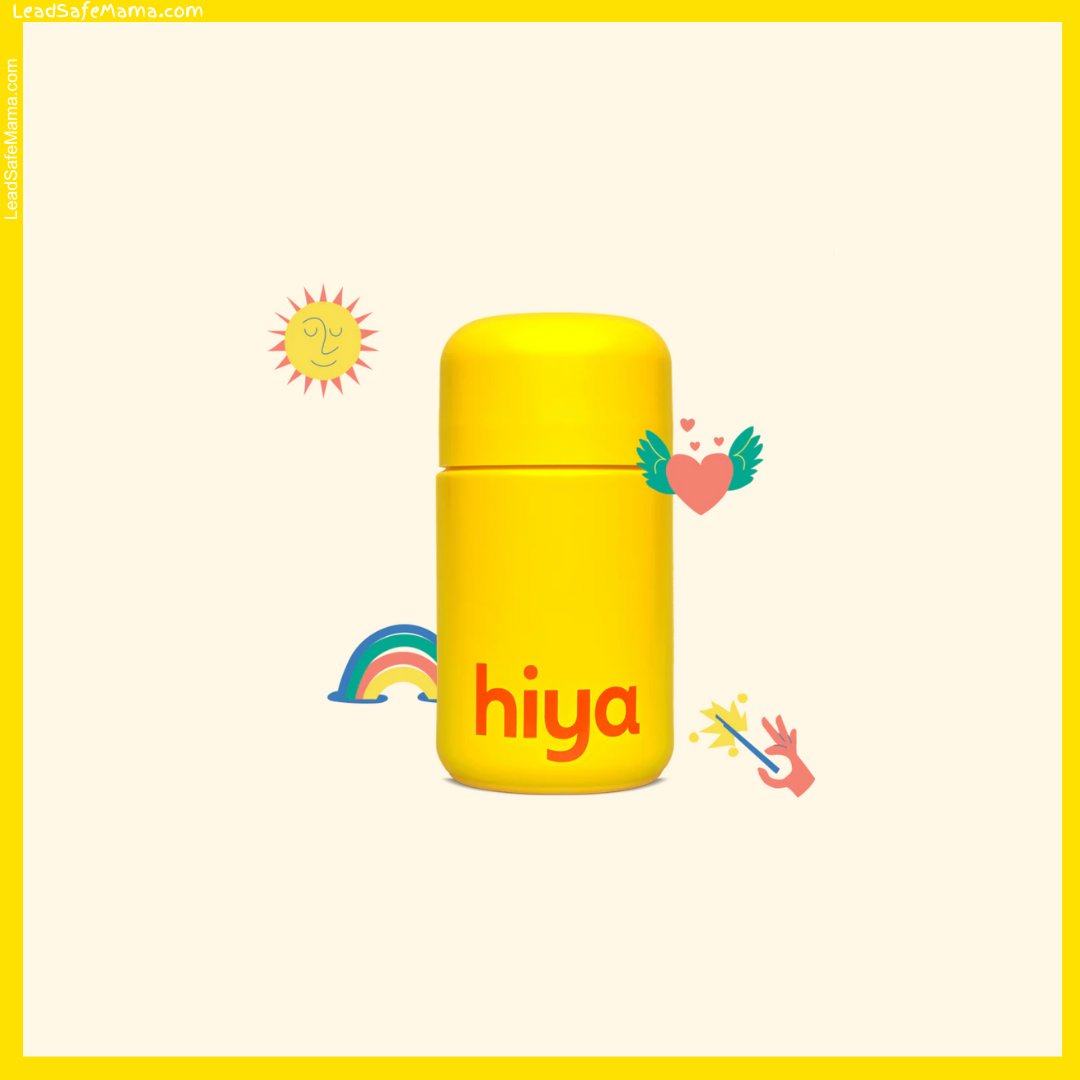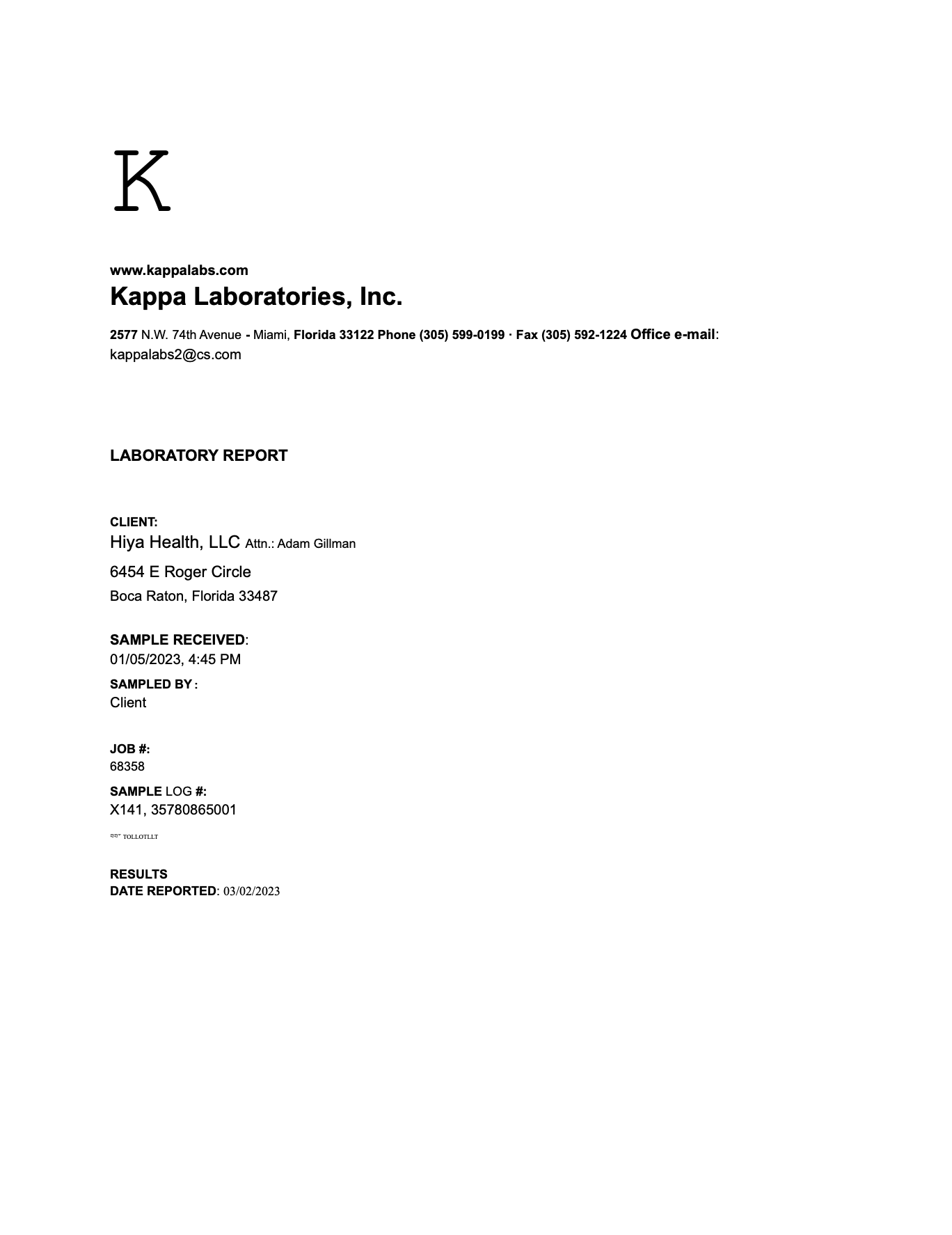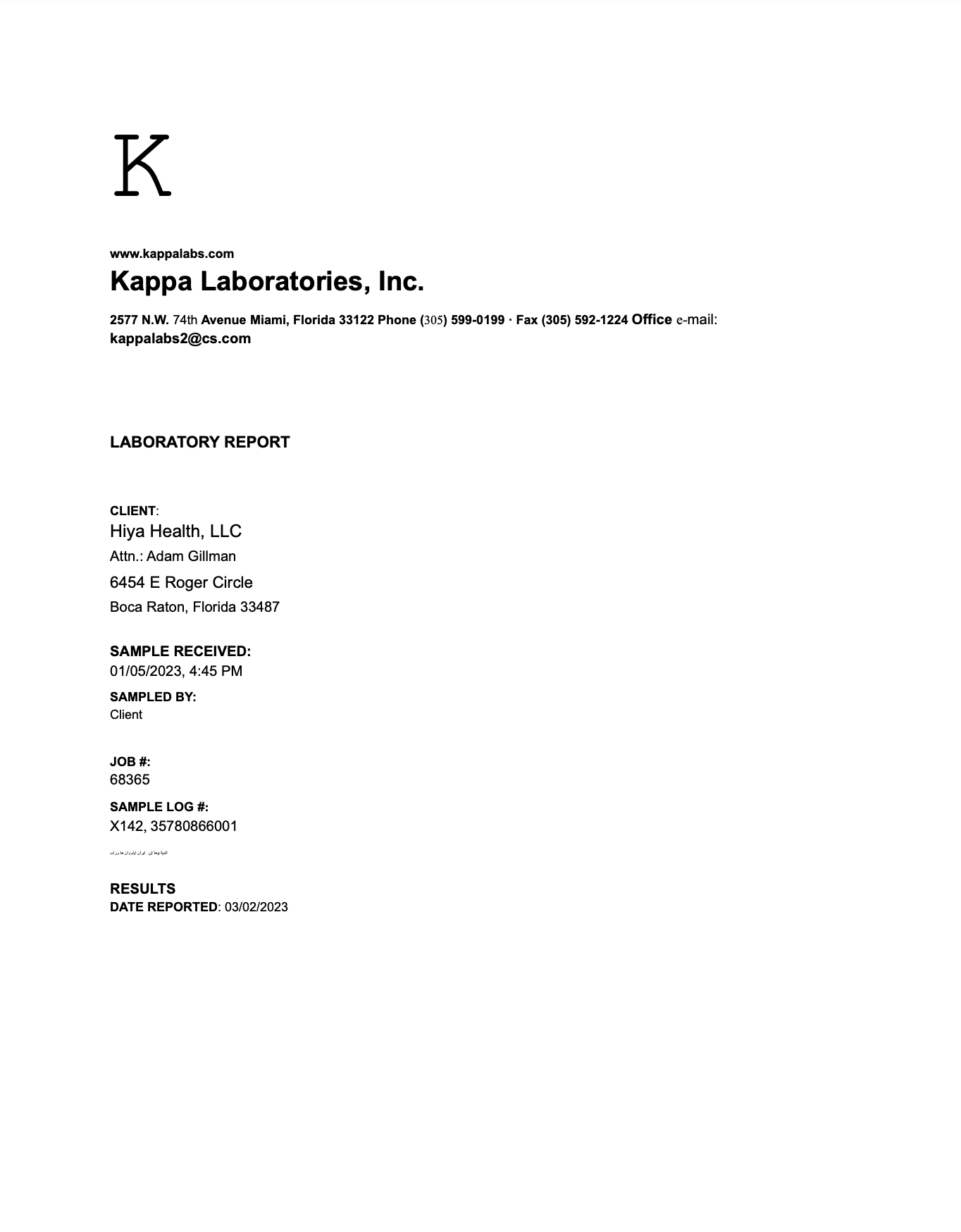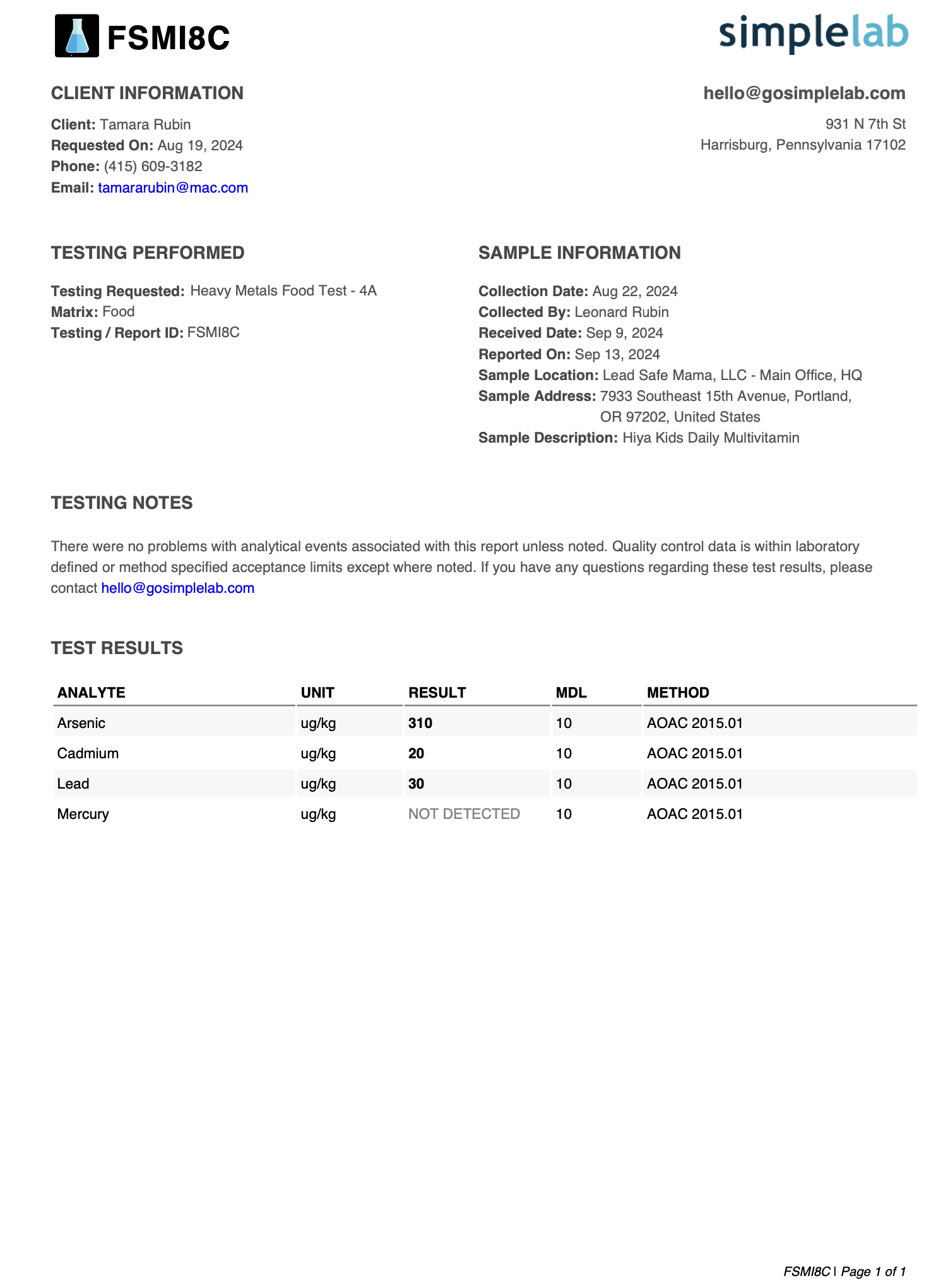“Lab Reports” Hiya is sending to Lead Safe Mama community members in response to inquiries about our findings of Lead, Cadmium, & Arsenic in their Kids Daily Multivitamins
Published: September 18, 2024
To see an example of the lab reports Hiya is sending out, please scroll down (click the image of the first page on either of the “reports” linked below to see a full three-page report for each of the two flavors).
Examples of the lab reports Hiya has been sending (two are linked below) indicate a couple of key points, with the overarching consideration being that these reports clearly detail how Hiya has completed insufficient laboratory testing to support claims that they “test for heavy metals” (a public statement they have repeated ad nauseam, which implies to customers that their products are free of heavy metals, regardless of whether-or-not it is true).
This is the same playbook as all of the Clean Label Project Purity Award-Winning products we have tested and found to test positive for unsafe levels of heavy metals (specifically Lead, Cadmium, Mercury, and Arsenic). Corporate statements that tell customers a company “tests for heavy metals” always gives the appearance of due diligence, even if the testing is insufficient (in scope or frequency).
Here are the two specific points of concerns about these particular lab reports (which were received by a Lead Safe Mama community member and then forwarded to us):
- The product was sampled by the “client,” which appears to indicate Hiya directly sent the sample.
- If the manufacturer is sending in its product for testing (and paying for that testing), it is then (by default) NOT “independent, third-party testing,” as there is the opportunity for the manufacturer to influence which product is sent in alongside other chain-of-custody considerations.
- While we don’t think this is necessarily a concern in this case, it is a key point to highlight (as so many companies claim “independent third-party testing” when the testing is anything but that).
- For truly independent, third-party testing, the agency conducting the testing would collect the sample from items available for purchase (not items selected and sent in by the manufacturer), so the sample tested is random and not influenced by the manufacturer in any way.
- Their conclusion from this “report” is that the metals analyzed were “not detected,” but there is no notation on either three-page report indicating the low threshold of detection for this testing (or the units of measurement involved… was it recorded in ppm? Or ppb?).
- In light of the results from the laboratory testing Lead Safe Mama, LLC completed, the Hiya “reports” are a clear indicator the company did not test to a low enough threshold of detection to rule out the presence of heavy metals at levels that are concerning for children’s health.
- Most supplement companies only test down to 1 part per million or even 5 parts per million (1,000 ppb or 5,000 ppb) — not appropriately down to the single or double-digit parts per billion levels that would be protective of children’s health.
That’s it — that’s all you need to know about these “reports” (and why they differ from the laboratory testing we conducted on this product, which tested down to a low threshold of detection of 10 parts per billion) — please take a look at them below and let us know if you notice anything else we should highlight as a consideration!
Thanks for reading!
Additional reading that may be of interest:
- Here’s our original article discussing the Lead Safe Mama, LLC laboratory testing for this product.
- This is Hiya’s initial response to that laboratory testing.
The Hiya “report” for their Green Apple Flavor vitamin product:
The Hiya “report” for their Berry Flavor vitamin product:
The Lead Safe Mama, LLC lab report for the Hiya Kids Daily Multivitamin product:
Never Miss an Important Article Again!
Join our Email List










In the lab report supplied by Hiya, it says “EPA 6010” under the reporting for each of the metals. Anyone know what that means? Could that refer to the threshold level that they are testing for?
More info here (not an indicator of level of detection as I understand it): https://www.epa.gov/esam/epa-method-6010d-sw-846-inductively-coupled-plasma-atomic-emission-spectrometry
EPA 6010 refers to the laboratory test method. Laboratory test methods specify a set of standard procedures, equipment, and methods used to prepare and analyze the sample. The test method typically indicates the method detection limit (the minimum/lowest detection limit achievable with that method), but that’s not a guarantee that the method detection limit is actually achieved. Detection limits can vary due to lab instrumentation. Sample physical properties and the concentrations of other chemicals in the sample can also interfere with analysis and result in higher detection limits. Ultimately detection limits are sample specific and thus typically reported for every chemical/analyte for every sample. That context is important in making a non-detect result meaningful. So I’m surprised that Hiya’s lab report doesn’t include detection limits.
Yes! Me too!
I’m gona cancel my kids subscriptions of their probiotics and reference Tamara’s findings for the multivitamins. I wonder how butthurt they will be ♀️
Yes that is confusing the EPA 6010. Think maybe Consumer Reports might be interested in looking at the world of children’s vitamins. Their little bodies can’t take what adult bodies can! Breaks my heart not to be able to trust the depiction of “Clean and safe” family owned concern. Just feels kind of sinister and these products are substantially priced!!
It would be interesting to see what the detection limits are for Hiya’s testing. Since federal criteria for metals content in food/supplements don’t exist, you can say you test but what does that mean if there are no criteria to meet? I see how “third party testing” has become a form of health-washing (new word, ha!), it sounds good but is meaningless without either some sort of transparent criteria you are screening against or at least providing the actual range of concentrations (including detection limits for non-detect results) in your products.
What is a better choice of a clean multivitamin
We have not found one yet. If you or your child have been determined by a doctor to need vitamins – please consider asking for a prescription option, as prescriptions tend to be much cleaner (from a heavy metal perspective) and generally better regulated for health-related values.